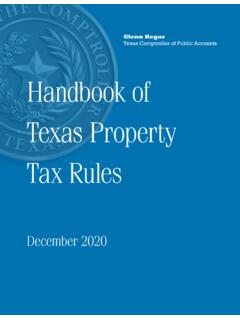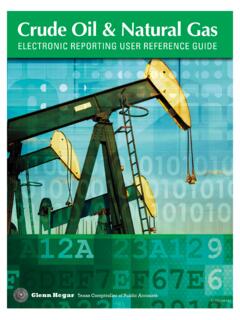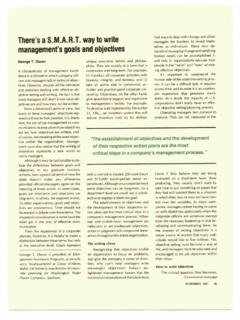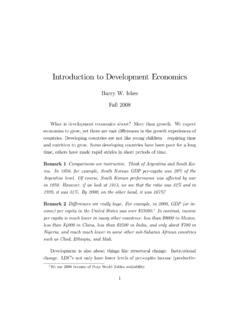Transcription of 96-300 Manual for the Appraisal of Agricultural Land
1 Manual for the Appraisal ofAgricultural LandOctober 2020 Glenn HegarTexas Comptroller of Public AccountsB Manual for the Appraisal of Agricultural LandManual for the Appraisal of Agricultural Land iTexas Property TaxTable of ContentsIntroduction .. 1 Open-Space and Ag-Use Appraisal Laws Compared .. 2 Roles of Appraisal Districts and Tax Offices .. 3 Qualification of Land Under Section 1-d-1 .. 4 Eligibility Requirements .. 41. 1-d-1 Land and Appurtenances.. 42. Current and Principal Agricultural Use .. 53. Degree of Intensity Test .. 84. Time Period Test .. 9 Cessation of Agricultural Use .. 9 Drought .. 9 Owner Deployed or Stationed Outside State as Member of Armed Services .. 10 Land with Citrus Production Located in Pest Management Zone .. 10 Oil and Gas Operations on Land .. 10 Land with Livestock Located in a Tick Eradication Area.
2 10 Land Located Within the Boundaries of a City or Town .. 11 Land Owned by a Non-Resident Alien or Foreign Government .. 11 Ecological Laboratories .. 11 Waiver of 1-d-1 Appraisal .. 11 Application Process for 1-d-1 Appraisal .. 13 Application Forms .. 13 Filing Deadline and Extension .. 13 Late Applications and 10 Percent Penalty .. 14 Failure to File the Application Form .. 14 One-Time Application .. 14 Penalty for Failure to Provide Notice of Change in Category or Class Use or Eligibility .. 14 Change in Category or Class Use.. 14 Penalty May Be Treated as a Delinquent Tax.. 15 Erroneously Granted Special Appraisal .. 15 Chief Appraiser s Action .. 15 Additional Information .. 16 Summary of the 1-d-1 Application Process .. 16ii Manual for the Appraisal of Agricultural LandAgricultural Appraisal Under Section 1-d-1.
3 17 Types and Sources of Information .. 18 Farm Service Agency.. 19 National Agricultural Statistics Service.. 19 Natural Resources Conservation Service.. 19 Agricultural Credit Associations .. 19 Texas A&M AgriLife Extension Service .. 19 Universities and Colleges.. 20 Agricultural Advisory Board .. 20 Other Sources.. 20 Establishing Land Classes .. 20 Determining Net to Land Values .. 21 Cash Lease Method .. 21 Terms of Lease .. 21 Additional Costs .. 21 Share Lease Method .. 22 Calculating Net to Land Values.. 23 Calculating Net Income for a Typical Share Lease.. 23 Unavailable Leases-Alternative Methods .. 24 Developing the Appraisal Schedule .. 25 Classifying Individual Parcels .. 25 Appraising Individual Parcels .. 25 Federal Farm Programs.
4 262018 Farm Bill .. 26 The Conservation Reserve Program (CRP).. 26 Agriculture Risk Coverage (ARC) .. 27 Price Loss Coverage (PLC).. 27 Other Federal Programs.. 28 Rollback Procedure on 1-d-1 Land .. 29 What Qualifies as a Change of Use? .. 29 Change of Use Notification.. 30 Taxes for the Year Use Changes .. 31 Calculating the Rollback .. 31 Gaps in the Three-Year Period .. 31 Rollback Taxes Due Date.. 32 Exempt Entities .. 32 Exceptions to Rollback Sanctions .. 32 Questions and Answers about Rollback Procedures .. 33 Manual for the Appraisal of Agricultural Land iiiAgricultural Appraisal Under Section 1-d .. 34 Application Procedures .. 35 Late Applications .. 35 Chief Appraiser s Action .. 36 Additional Information .. 36 Confidentiality of Applications.
5 36 Appraisal Procedures for 1-d Land .. 36 Cessation of Agricultural Use .. 37 Land with Livestock Located in a Tick Eradication Area .. 37 Rollback Procedures for 1-d Appraisal .. 37 Rollback Notification .. 37 Rollback Exceptions .. 381-d and 1-d-1 Rollback Comparison .. 38 Rollback Calculation .. 38 Combining 1-d and 1-d-1 Rollbacks .. 39 Appendix A .. 40 Questions and Answers About 1-d-1 Qualification .. 40 Appendix B .. 46 Estimating Lease Terms From Owner-Operator Budgets .. 46 Appendix C .. 48 Sample Development of Class Values .. 48 The County .. 48 Native Pasture .. 48 Improved Pasture .. 50 Dry Cropland .. 51 Irrigated Cropland .. 52 Individual Property Appraisal .. 53 Appendix D .. 54 Figures.
6 54iv Manual for the Appraisal of Agricultural LandManual for the Appraisal of Agricultural Land 1 Texas Property TaxIntroduction-Until the 1960s, Texas farm and ranch land was taxed on its market value the price a buyer would pay for it in an ordi-nary market transaction. As Texas became more urbanized, farm and ranch land in many cases increased dramatically in value, especially in developing areas. Even if a farmer or rancher never intended to develop the land, its value increased because it could be 1966, Texas voters approved the first Agricultural Appraisal law. A constitutional amendment added Section 1-d to Ar-ticle VIII of the Texas Constitution. This amendment and the Appraisal statutes that implement it 2provides that cer-tain kinds of farm land can be appraised at its value based on the land s capacity to produce Agricultural products, not at market value. In many cases, this Appraisal technique sub-stantially reduces taxation of land that qualifies for agricul-tural Appraisal .
7 This special Appraisal technique has several popular names including productivity valuation, productivity Appraisal , special Appraisal and Agricultural (ag) Appraisal . 134 Tax Code Chapter 23, Subchapter C (Sections ) governs the Appraisal of land designated for Agricultural use pursuant to Texas Constitution Article VIII, Section 1-d and is referred to as 1-d or ag-use Appraisal 1-d is restrictive, applying only to land owned by families or individuals. Agriculture must be the property owner s primary occupation and source of income. In 1978, Texas voters approved a second constitutional amendment adding Section 1-d-1, allowing open-space land (as well as timberland) to be appraised based on its productiv -ity value. This amendment allows eligibility for productivity Appraisal for 5corporations as well as individuals; there are no income or occupation tests. This constitutional amendment 1 Tex. 79, 59th Reg. Sess. (1965)2 Tex.
8 Tax Code Tex. Tax Code (a)4 These popular Appraisal names are used interchangeably and when referring to appraisals under either the 1-d or 1-d-1 Tex. 1, 65th 2nd Called Sess. (1978)took effect in 1979. Tax Code Chapter 23, Subchapter D (Sec-tions ) governs the Appraisal of Agricultural land pursuant to Texas Constitution Article VIII, Section 1-d-1 and is also referred to as the 1-d-1 or open-space Appraisal law. Because most of the eligible land in Texas now qualifies under the open-space law, this Manual emphasizes its par-ticular procedures and 1995, Texas voters approved amending Texas Constitution Article VIII, Section 1-d-1 to permit Agricultural Appraisal for land used to manage Tax Code assigns most Agricultural Appraisal responsi-bilities to the chief appraiser but directs the Comptroller s office to promulgate rules specifying the methods to ap-ply and the procedures to use in appraising land designated for Agricultural use, under the 1-d The Comptroller, by rule, must develop Appraisal manuals for qualified open-space land under the 1-d-1 The Comptroller s office carries out these duties by developing this Agricultural ap-praisal Manual .
9 Adopting it by rule9 and making it available on its Appraisal districts are to use this Manual in appraising qualified open-space land and ag-use Ex-amples and figures are illustrative and not mandatory. This Manual is adopted under the rule-making authority of the Comptroller s Property Tax Assistance Division (PTAD)with the review and counsel of the Texas Department of In addition to this Manual , PTAD also publishes a Manual for the Appraisal of Timberland that describes application, qual-ification, Appraisal and rollback procedures for timberland, as 6 Tex. 72, 74th Reg. Sess. (1995)7 Tex. Tax Code (b)8 Tex. Tax Code (d)9 34 Tex. Admin. Code Tex. Tax Code and 11 Tex. Tax Code (d) and (b)12 Tex. Tax Code (d)2 Manual for the Appraisal of Agricultural Landwell as Guidelines for Qualification of Agricultural Land in Wildlife Management and Ag-Use Appraisal Laws ComparedSeveral elements are common to both the open-space and ag-use laws: A property owner must apply for Agricultural Appraisal .
10 The owner must file a special form with the Appraisal dis-trict before the The Agricultural Appraisal applies only to land, fences and certain appurtenances. It does not apply to improvements or The chief appraiser must act on each application received and notify the property owner if the chief appraiser denies the application or needs more Tex. Tax Code and Tex. Tax Code and Tex. Tax Code and A property owner may appeal the denial of Agricultural ap-praisal and a change of use determination to the Appraisal review Land that receives Agricultural Appraisal is subject to a tax penalty (rollback tax) and interest when taken out of agri-cultural Property qualified as 1-d or 1-d-1 land (other than wildlife management) that is subject to a temporary quarantine of at least 90 days for ticks may be reappraised. The effect on the value of the land caused by the tick infestation is an ad-ditional factor to be taken into 1 contrasts some of the key differences in the two Tex.













